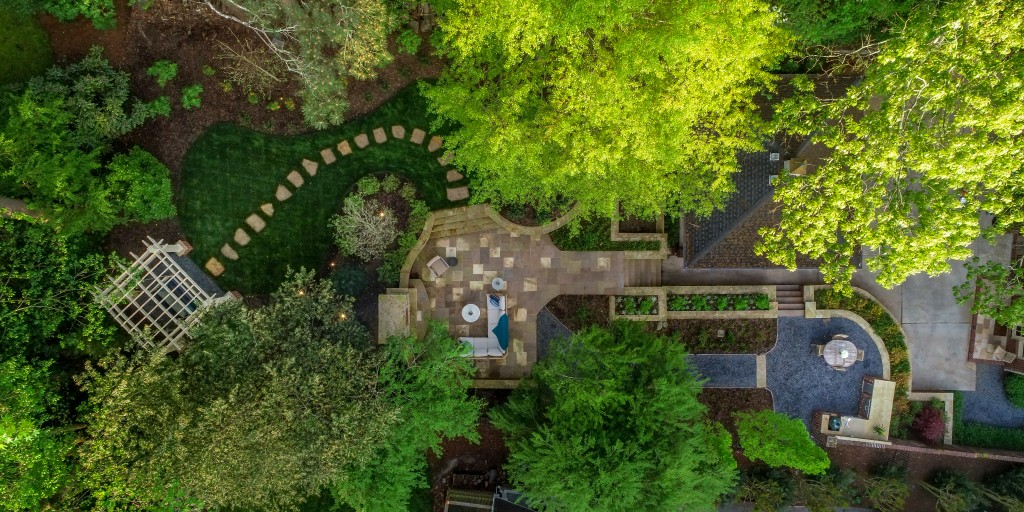All About Landscape Design
Table of ContentsLandscape Design Can Be Fun For AnyoneGet This Report on Landscape DesignMore About Landscape DesignSome Of Landscape Design
Formal design theme. Credit History: Gail Hansen, UF/IFAS The lawn is an expansion of the home where a variety of tasks happen. A lawn can generally be split right into three areas: public (the front lawn), exclusive (the garden), and service (commonly the side yard). The place of activity areas depends mostly on the type of location, the dimension of area required, the sort of activity, and the wanted closeness to other tasks and structures (Landscape Design).
The outdoors wall surface of your house typically works as the very first wall surface or beginning point of an exterior room. Incompatible usages ought to be separated, and relevant tasks, such as food preparation and dining, should be assembled to make the yard more reliable and satisfying. When using hardscape to produce rooms, make use of building material comparable to that used in your home for connection from your home right into the garden.
Connected rooms. Credit Score: Gail Hansen, UF/IFAS Using comparable hardscape features and repeating plants pulls the eye around the yard.
This provides a feeling of secret that advertises expedition and exploration of the landscape. From a design perspective, plant materials have 3 major functions in the landscape: visual, architectural and utilitarian. Cosmetically, plants create a visually pleasant setting and structurally plants organize and specify areas. Plants are utilitarian due to the fact that they can transform the setting for the comfort of the customer by customizing light, temperature and moisture.
6 Easy Facts About Landscape Design Shown
For psychological convenience plants are made use of as physical or implied barriers for personal privacy and safety and security. Physical obstacles obstruct both the sight and access to an area and consist of fencings, wall surfaces and plant bushes. Landscape Design. Implied barriers, generally reduced expanding plants, obstruct access however not the sight (Number 9). Various other functions of plants consist of cleaning the air, protecting against erosion and dirt loss, keeping dampness in the soil, and returning natural issue to the soil.
Physical and suggested obstacles. Credit Report: Gail Hansen, UF/IFAS For these factors, the kinds of plants to be used (such as trees, shrubs, or groundcovers) ought to be selected in the beginning of planning. Plant kinds are selected for their practical abilities to ensure that their future function and needed area can be thought about at the exact same time.
The above plane, the vertical plane and the ground plane should all be taken into consideration to develop room. When the shape of a plant bed has been established, the plants should be massed (organized) and split to accomplish visual unity and the wanted quantity of room. The size of a plant mass will certainly rely on the overall size of the backyard, the dimension of the specific plants in the mass, and the emphasis or impact preferred from the plant material.
Each plant mass is in front sites of, behind, or alongside, another mass. Figure 11. Horizontal plant layers. Credit Scores: Gail Hansen, UF/IFAS Number 12. Upright plant layers. Debt: Gail Hansen, UF/IFAS Repeating plants within a mass and duplicating masses with similar plants connects the garden with each other. The specific plant features have to be taken into consideration to effectively layer and mass plants.
Unknown Facts About Landscape Design
All plant make-ups begin with the main structure plants, the big, mainly evergreen history plants-such as the trees and huge hedges. These plants different or enframe spaces, control the size of the space, and supply the beginning factor for choosing the appropriate attributes of the 2nd layer, midground plants, for massing and infill.
Vital points in the garden should be highlighted by the usage of special plants, distinctive frameworks, or yard ornaments. Marking thresholds or entrances to spaces can be performed with gateways, arbors, and actions, or with using one-of-a-kind and vivid plants. The kind and/or style theme of the garden will frequently help identify the crucial factors and how they ought to be highlighted.
Other important areas in the backyard are focal factors, which is utilized to visually arrange a designed location. The kind of prime focus typically depends upon the checking out viewpoint. Various perspectives or perspectives can disclose various compositions in the landscape that may call for a selection of centerpieces. Contrasting structure, form, size and color will record and hold the eye.
The Greatest Guide To Landscape Design
Figure 13. Plant kinds. Credit History: Gail Hansen, UF/IFAS After kind, texture is the following leading feature of a plant; rugged, tool and fine textures can be utilized for comparison and emphasis in the landscape. Kind and structure both trump shade in the yard for the majority of the year. However, throughout specific periods, color will be the most obvious feature of the yard.


The pleasant fragrance of plants, the noise of wind in the trees, the audio and texture of water, linked here and the colors and structures of sculptures, pots and yard furnishings all add to the experience of the garden. One information that is usually overlooked is the impact of light on the appearances of the plants.
The whole garden adjustments in feature and appearance over the program of the day, and the program of a year, as the light and temperature change from early morning to evening and season to season. Plant option have to take into consideration a plant's development rate, its mature size and kind, and the upkeep it will require.
It is important to know the ultimate mature dimension of plants so they can be put in Recommended Reading the right place and spaced appropriately when they are mounted. Providing plants room to grow is an obstacle because the common fully grown size is generally based on optimum growing problems and the environmental conditions of a website may cause a plant to enlarge or stay smaller.